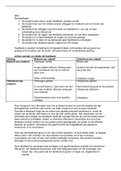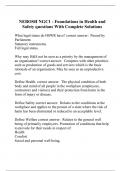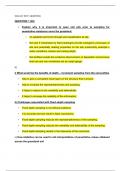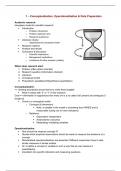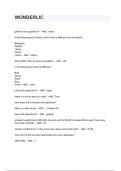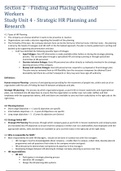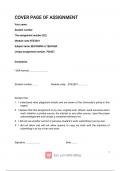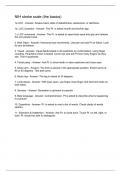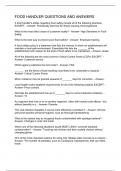○
P,
T,
V,
S,
U,
H,
A,
and
G
(last
six
molar)
are
eight
intensive
thermodynamic
state
values
for
which
if
two
are
fixed
in
a
pure,
single-phase
system,
so
is
the
entire
set
-
Extensive
versions:
three
needed
○
Starting
point:
U
=
Q
+
W,
and
S
=
Q/T
→
dU
=
TdS
-
PdV
for
a
closed,
one-component
system
-
H
=
U
+
PV
→
dH
=
TdS
+
VdP
-
G
=
H
-
TS
→
dG
=
VdP
-
SdT
-
A
=
U
-
TS
→
dA
=
-SdT
-
PdV
○
Use
expanded
differential
and
above
for
some
properties;
mixed
partials
for
Maxwell
relations
Second
dU
and
dH
eqs
come
from
expanding
out
dS,
below
from
6.2-19
above
where
S
=
S(T,V)
0r
S
=
S(T,P)
and
Maxwell
J-T
coeff
expanded
comes
from
second
dH
=
0
Can
also
use
those
to
get ○
Equations
of
state:
-
van
der
Waals:
(P
+
a/V^2)(V-b)
=
RT
-
Redlich-Kwong:
(no
T^½
in
denominator
in
generalized
form)
-
Peng-Robinson:
-
Virial:
Z
(compressibility
factor)
=
PV/RT
=
1
+
B/V
+
C/V^2
+
…;
B
=
B(T)
=
2nd
Virial
coeff
(truncated
good
for
low
densities;
not
applicable
to
liquids)
○
Departures
from
IG
section
…
they
use
it
to
make
those
terrible
many-line
plots
we
used
in
Unit
1
○
Corresponding
states:
if
two
fluids
follow
the
same
EOS,
if
two
of
P/V/T
reduced
is
the
same,
so
is
the
third
(use
this
to
find
a
and
b
in
vdW;
Z_c
=
3/8)
○
Acentric
factor
proposed
to
improve
generalization
of
Z
as
a
function
of
reduced
P
and
T
(but
still
depends
on
polarity
of
molecule,
etc.)
○
Peng-Robinson
is
also
discussed
but
I
doubt
Effie
wants
us
to
do
that
math
○
Thermo
laws:
1)
energy
conservation
2)
entropy
generation
3)
entropy
0
only
in
“perfect”
state
at
absolute
0
K
(or
more
correctly,
the
same
value
of
S,
which
is
taken
to
be
0
for
reference)
-
However
from
6.2-20,
lim
(dS/dT)
as
T
→
0
at
constant
P
=
c_p/T
=
infinity,
but
since
G
=
H
-
TS
converges
to
H
as
T
→
0,
entropy
must
be
finite
(so
0
not
possible)
Chapter
7:
Equilibrium
and
Stability
in
One-Component
Systems
○
Start
with:
and𝑑𝑈𝑑𝑡= 𝑄 ̇−𝑃𝑑𝑉𝑑𝑡𝑑𝑆𝑑𝑡=𝑄 𝑇+𝑆𝑔𝑒𝑛
-
At
constant
U,
V
and
no
time-change:
Q
=
0,
so
dS/dt
=
S_gen,
and
so
S
must
be
maximum
-
Expanding
S(U,V,N)
and
considering
dX_I
for
each
=
-dX_II:
everything
must
be
uniform
-
Constant
T,
V:
multiply
dS
equation
by
T
then
subtract
from
dU
to
get
d(U-TS)/dt
=
-TS_gen
<=0
→
A
must
be
minimum
-
Constant
T,
P:
becomes
d(U
+
PV
-
TS)/dt
=
-TS_gen
<=0
→
G
must
be
minimum
○
Stability:
consider
second
derivatives
…
and
do
a
lot
of
math
to
find
that
c_v
>
0
and
dP/dV
|
T
<
0
○
Two
interacting
phases:
the
above
must
be
true
for
each
subsystem
-
Leads
to
creation
of
V-L
equilibrium
bump
in
PV
plots
(straight
line
in
place
of
positive
slopes)
-
Graph:
G
same,
and
G
=
int(VdP)
and
constant
T
→
I
and
II
should
have
the
same
area
-
At
critical
temperature:
dG/dT
|
P
(=
S)
is
same
for
L
and
V;
two
phases
are
indistinguishable
-
Also
explains
superheated
liquids
and
subcooled
vapors
(stability
beyond
horizontal)
○
Fundamental
equation:
dG/dP
=
V,
do
dG
=
VdP,
and
subbing
IG
leads
to
(all
gasses
ideal
at
P
=
0)
P,
T,
V,
S,
U,
H,
A,
and
G
(last
six
molar)
are
eight
intensive
thermodynamic
state
values
for
which
if
two
are
fixed
in
a
pure,
single-phase
system,
so
is
the
entire
set
-
Extensive
versions:
three
needed
○
Starting
point:
U
=
Q
+
W,
and
S
=
Q/T
→
dU
=
TdS
-
PdV
for
a
closed,
one-component
system
-
H
=
U
+
PV
→
dH
=
TdS
+
VdP
-
G
=
H
-
TS
→
dG
=
VdP
-
SdT
-
A
=
U
-
TS
→
dA
=
-SdT
-
PdV
○
Use
expanded
differential
and
above
for
some
properties;
mixed
partials
for
Maxwell
relations
Second
dU
and
dH
eqs
come
from
expanding
out
dS,
below
from
6.2-19
above
where
S
=
S(T,V)
0r
S
=
S(T,P)
and
Maxwell
J-T
coeff
expanded
comes
from
second
dH
=
0
Can
also
use
those
to
get ○
Equations
of
state:
-
van
der
Waals:
(P
+
a/V^2)(V-b)
=
RT
-
Redlich-Kwong:
(no
T^½
in
denominator
in
generalized
form)
-
Peng-Robinson:
-
Virial:
Z
(compressibility
factor)
=
PV/RT
=
1
+
B/V
+
C/V^2
+
…;
B
=
B(T)
=
2nd
Virial
coeff
(truncated
good
for
low
densities;
not
applicable
to
liquids)
○
Departures
from
IG
section
…
they
use
it
to
make
those
terrible
many-line
plots
we
used
in
Unit
1
○
Corresponding
states:
if
two
fluids
follow
the
same
EOS,
if
two
of
P/V/T
reduced
is
the
same,
so
is
the
third
(use
this
to
find
a
and
b
in
vdW;
Z_c
=
3/8)
○
Acentric
factor
proposed
to
improve
generalization
of
Z
as
a
function
of
reduced
P
and
T
(but
still
depends
on
polarity
of
molecule,
etc.)
○
Peng-Robinson
is
also
discussed
but
I
doubt
Effie
wants
us
to
do
that
math
○
Thermo
laws:
1)
energy
conservation
2)
entropy
generation
3)
entropy
0
only
in
“perfect”
state
at
absolute
0
K
(or
more
correctly,
the
same
value
of
S,
which
is
taken
to
be
0
for
reference)
-
However
from
6.2-20,
lim
(dS/dT)
as
T
→
0
at
constant
P
=
c_p/T
=
infinity,
but
since
G
=
H
-
TS
converges
to
H
as
T
→
0,
entropy
must
be
finite
(so
0
not
possible)
Chapter
7:
Equilibrium
and
Stability
in
One-Component
Systems
○
Start
with:
and𝑑𝑈𝑑𝑡= 𝑄 ̇−𝑃𝑑𝑉𝑑𝑡𝑑𝑆𝑑𝑡=𝑄 𝑇+𝑆𝑔𝑒𝑛
-
At
constant
U,
V
and
no
time-change:
Q
=
0,
so
dS/dt
=
S_gen,
and
so
S
must
be
maximum
-
Expanding
S(U,V,N)
and
considering
dX_I
for
each
=
-dX_II:
everything
must
be
uniform
-
Constant
T,
V:
multiply
dS
equation
by
T
then
subtract
from
dU
to
get
d(U-TS)/dt
=
-TS_gen
<=0
→
A
must
be
minimum
-
Constant
T,
P:
becomes
d(U
+
PV
-
TS)/dt
=
-TS_gen
<=0
→
G
must
be
minimum
○
Stability:
consider
second
derivatives
…
and
do
a
lot
of
math
to
find
that
c_v
>
0
and
dP/dV
|
T
<
0
○
Two
interacting
phases:
the
above
must
be
true
for
each
subsystem
-
Leads
to
creation
of
V-L
equilibrium
bump
in
PV
plots
(straight
line
in
place
of
positive
slopes)
-
Graph:
G
same,
and
G
=
int(VdP)
and
constant
T
→
I
and
II
should
have
the
same
area
-
At
critical
temperature:
dG/dT
|
P
(=
S)
is
same
for
L
and
V;
two
phases
are
indistinguishable
-
Also
explains
superheated
liquids
and
subcooled
vapors
(stability
beyond
horizontal)
○
Fundamental
equation:
dG/dP
=
V,
do
dG
=
VdP,
and
subbing
IG
leads
to
(all
gasses
ideal
at
P
=
0)

